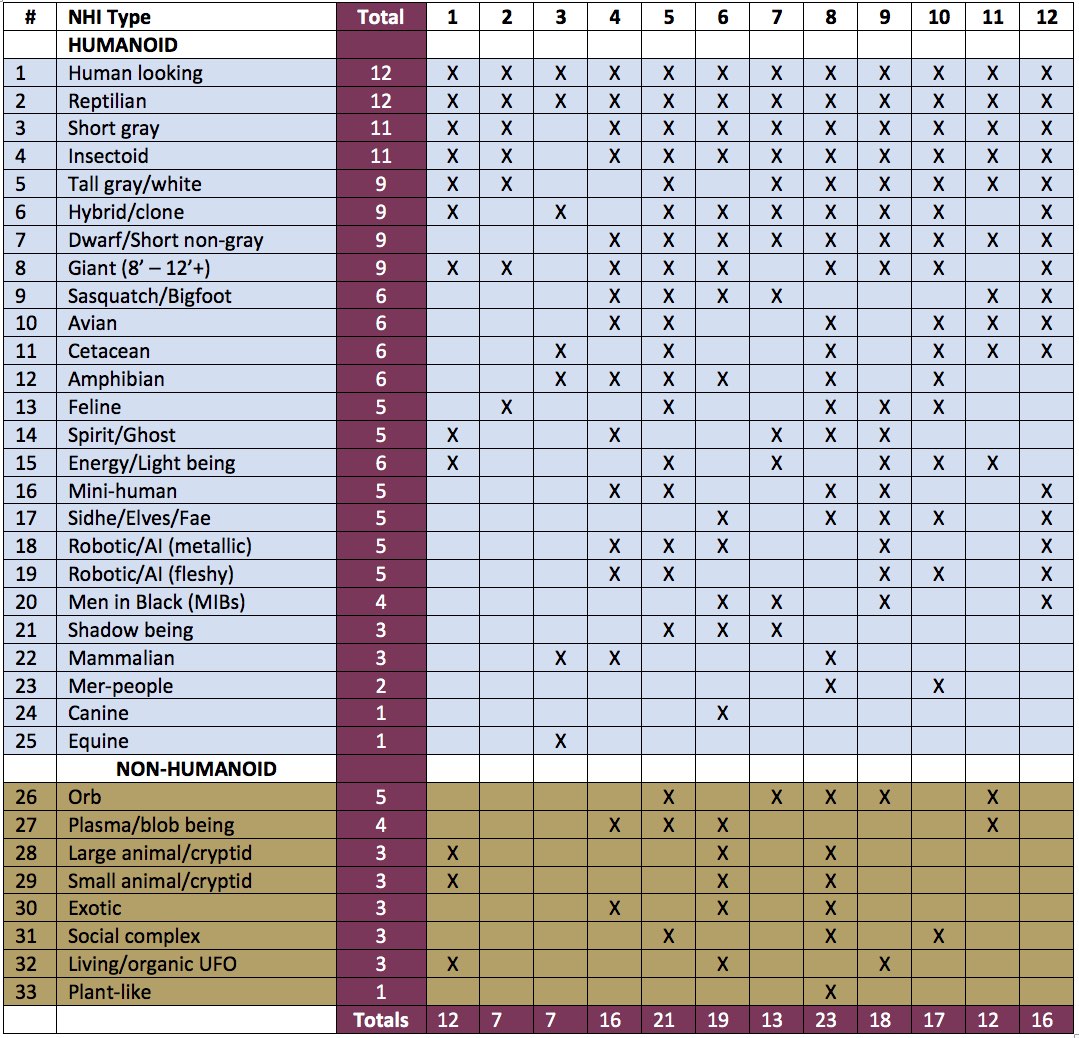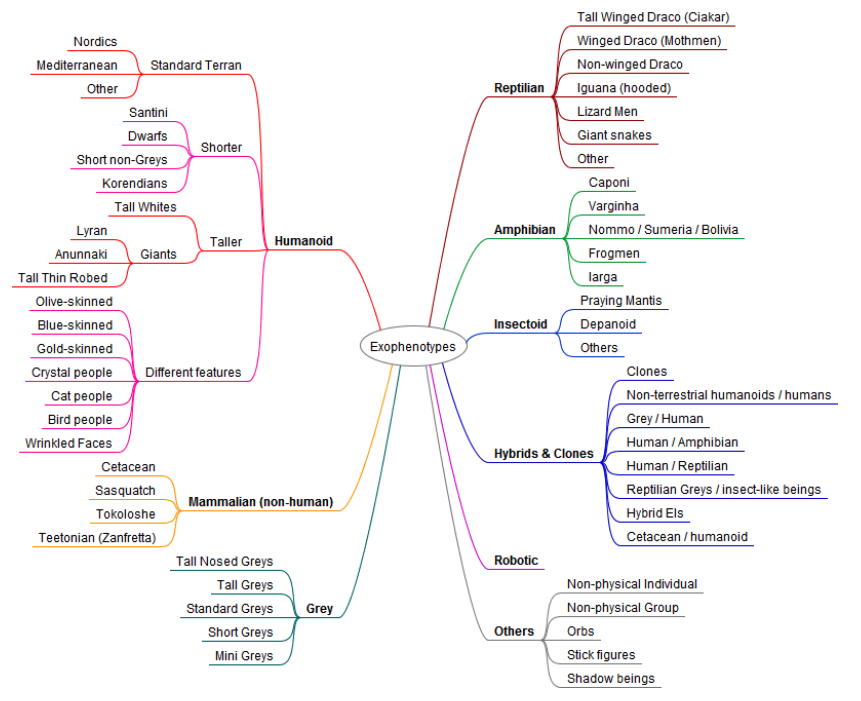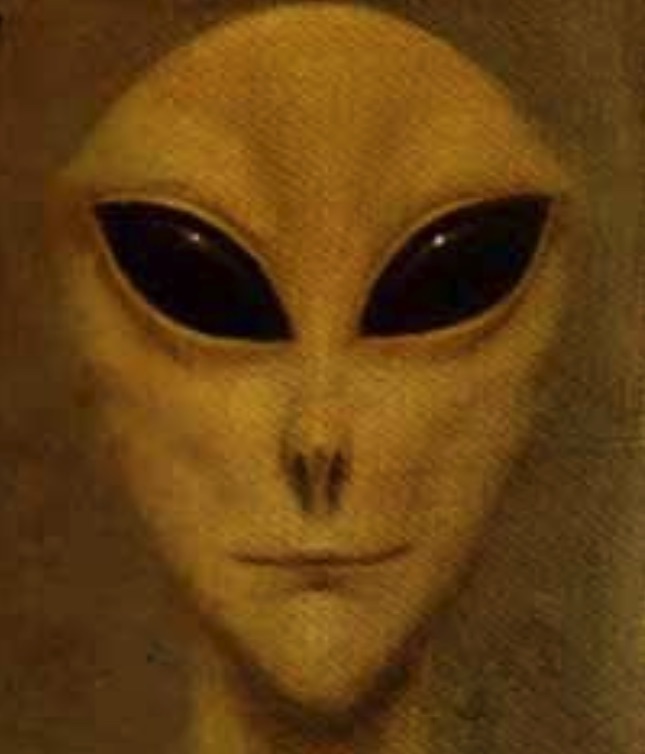5-minute reading time
Sean Esbjörn-Hargens. (2020).
Literally, tens of thousands of encounters with various types of non-human intelligences (NHIs) have been documented over the last 2,000 years. Volumes and volumes of books are filled with these reports. Thus, it appears that humans have always been interacting with mysterious beings, and they seem to come in all shapes and sizes. Some are associated with folklore (e.g., gnomes, fairies, and strange creatures), others with religion (e.g., angels and demons), and some with UFOs.
In order to get an accurate sense of how many types of NHIs encounter humans in a UFO context, I identified 12 primary sources that provide an overview of NHIs or that contained numerous examples of various types of encounters. Sources produced their lists either through research and analysis of UFO literature, channeling NHIs, or talking directly with experiencers. Some sources were systematic while others were more idiosyncratic. A few sources dated to the mid-1990s, while the rest have occurred since 2012 and, as such, are quite recent.
The various authors and artists used to create the table below often devised their own systems of categorizing or organizing NHIs. Thus, they almost all use different labels or distinctions – though there was a lot of overlap among those more commonly reported (i.e., the top 5-8 types listed in the table) with more label divergence among the less-reported types.
I have created a general framework that accommodates the sources I have used here as well as additional sources not represented in the table. Some categories from the 12 sources overlapped with mine whereas others required that I translate their system into a more general set of distinctions. However, even these overlap a bit and sometimes a description of an NHI could be placed into more than one category.
The table illustrates the variety and distribution of NHIs found in the UFO literature from various modalities (channeled, direct encounters and first-person testimony, and research). This table or a slightly revised version could assist understanding NHI encounters in non-UFO contexts (e.g., folklore, psychedelics, cryptozoology, OBEs).
After the table an annotated bibliography of the twelve sources follows for those who want to explore in more detail.

Annotated Bibliography for Table Sources
1, Hernandez J.D., Reinerio; Schild, Ph.D. Rudy & Klimo Ph.D., Jon. (Editors). (2018, July 22). Beyond UFOs: The Science of Consciousness & Contact with Non Human Intelligence (Volume 1). Amazon CreateSpace Independent Publishing Platform.
- A five-year (2012–2017) quantitative and qualitative study with over 3,256 individuals from more than 100 countries who had single or multiple encounters with NHIs. The descriptions of NHIs span 10 distinct types. One was the catch-all category “Other”. For NHI encounters that took place within a UFO/UAP, 30% of all NHIs fell into the category of “other.” This was the fourth largest category of the 10. Similarly, for NHI encounters that did not take place in a “craft” but in a “matrix-like reality” 39.4% of all NHIs fell into “other.” This was the second largest category of the 10. Within “other” there around 1,350 responses representing “hundreds of types” of NHIs that did not easily fit into the other nine. (Rey Hernandez, personal communication, March 2, 2020). This underscores the wide variety of NHIs encountered and highlights that while there are around 8–10 common types, still much diversity characterizes NHI appearance (i.e., their phenotype).
- Salla, Michael E. (2013, May 14). Galactic Diplomacy: Getting to Yes with ET. Kealakekua, Hawaii: Exopolitics Institute.
- Salla presents 19 “extraterrestrial races” (12 positive and 7 negative types) from various planets and star systems in two tables summarizing their main activities including their positive or negative global impacts. Salla appears to analyze first-person testimony and the UFO literature in general. He focuses more on where these NHIs are from and their benevolent or malevolent orientation toward Earth humans than their phenotype.
- Nidle, Sheldan. (2005, June 1). Your Galactic Neighbors. Pukalani, Hawaii: Blue Lodge Press.
- A life-long experiencer, Nidle was approached during a meditation in the early 2000s by a council of 22 beings representing their respective civilizations from “across the galaxy.” Their goal was to work with him “to help the peoples of Earth overcome their strong aversion to the appearance of many of this galaxy’s highly intelligent inhabitants (p. xxi).” Nevertheless, these 22 “star-nations” allegedly represent only “a very narrow segment of the extraordinary array of cultures and species found throughout [the Milky Way Galaxy] (p. xxi).” Nidle explains that “many species, however, are not represented in this initial sample. They were omitted for a reason: their physical appearance is less than pleasing to limited conscious humans…” (p. xxii). Thus, these 22 types of beings are predominately “galactic humans” or humanoid in appearance. Nidle’s chapters present an overview of each star-nation, its location and ecology, social organization and cultural dynamics, their physical appearance and language, and a description of their ships.
- Huyghe, Patrick. (1996, October 1). The Field Guide to Extraterrestrials: A Complete Overview of Alien Lifeforms – Based on Actual Accounts and Sightings. New York: Avon Books.
- This was the first book to provide a typological system based on NHI phenotype. Thus, each entry is based on an actual close encounter documented with enough phenotypic detail to make an accurate drawing. Huyghe has been deliberate in his selection of cases so as to provide readers with a representative overview of NHI kinds. His system defines four classes (humanoid, animalian, robotic, and exotic) with 14 types spread across those four classes. In total, he showcases 49 different NHIs.
- Webre, Alfred Lambremont. (2014, March 21). The Dimensional Ecology of the Omniverse. Universe Books.
Webre’s presentation of NHIs draws heavily on the research of South African Manuel Lamiroy who has, more than anyone, mapped out the “exophenotypology” of NHIs. (see: https://www.exopaedia.org/Exophenotypology and http://www.exopoliticssouthafrica.org/phenotypes.htm) Below is a schematic of the nine- class exophenotypology that Lamiroy has developed to date. He is still incorporating dozens of new phenotypes after having gained access to a database of over 17,000 contact cases, most likely Albert Rosales database. Webre also discusses at length three Martian humanoid exophenotypes.

- Redfern, Nick. (2019, September 1). The Alien Book: A Guide to Extraterrestrial Beings on Earth. Canton, Michigan: Visible Ink Press.
- Redfern provides an encyclopedic overview of 44 different NHIs many of which are more commonly associated with cryptids or creatures of legends than with “aliens.” Nevertheless, he points out that “aliens come in all sizes, shapes, and colors. Some are friendly. Others are anything but friendly. They all have one thing in common: the human race has encountered them (p. xix).” Redfern’s compendium expands the categories beyond the stereotypical humanoid types most commonly associated with extraterrestrials.
- Howe, Linda Moulton. (1994). Glimpses of Other Realities: Volume 1: Facts and Eyewitnesses. Albuquerque, NM: Linda Moulton Howe Productions.
- In Chapters 3 and 4 Howe provides a variety of eyewitness reports and drawings by experiencers. She provides “different alien descriptions” of 10 types of beings each with numerous illustrations. Howe is an Emmy-award winning investigative journalist who graduated from Stanford University with a MA in Communications. She is considered by many to be one of the most established and well-respected UFO investigators in the field of UFO studies.
- Mendonça, Miguel. & Lamb, Barbara. (2015, December 12). Meet the Hybrids: The Lives and Missions of ET Ambassadors on Earth. Scotts Valley, CA: Amazon CreateSpace Independent Publishing Platform; Mendonça, M. (2017, March 16). Being with the Beings: The How and the Why of ET Contact. Scotts Valley, CA: Amazon CreateSpace Independent Publishing Platform.
- These two books feature 13 human individuals who self-identify as ET hybrids or who have had long-term ongoing contact with an impressive variety of NHIs. Their descriptions of various types of beings, their encounters with them, and the nature of their worlds/planets are detailed and compelling. All hybrids interviewed claim to have multiple types of ET DNA. Descriptions of the NHIs throughout these books often include where they come from, their phenotype, and their specific group names.
- Clarke, Ardy Sixkiller. (2012, November 26). Encounters with Star People: Untold Stories of American Indians. San Antonio, TX: Anomalist Books; — (2014, December 22). Sky People: Untold Stories of Alien Encounters in Mesoamerica. Pompton Plains, NJ: The Career Press, Inc; — (2016, July 25). More Encounters with Star People: Urban American Indians Tell Their Stories. San Antonio, TX: Anomalist Books; — (2019, May 17). Space Age Indians: Their Encounters with the Blue Men, Reptilians, and Other Star People. San Antonio, TX: Anomalist Books.
- Since the 1980s Ardy Sixkiller Clarke, an ethnographic researcher and Professor Emeritus at Montana State University, has collected over 4,000 NHI encounter stories from American Indians and other indigenous people globally. She has published 157 of those accounts in four books totaling 1,100 pages. Her body of work represents one of the most unique and important collections of experiencer accounts – especially since they all were recalled consciously without hypnosis. Also, her work shows that these encounters occur within populations often not associated with abduction phenomena or experiencer literature. Many encounters she documents appear to validate the many indigenous traditions globally, which speak about “Star Beings” as their ancestors.
- Narada, Vashta. Vashta Narada’s Galactic Art: Representations of entities from different densities, dimensions and realms of consciousness. www.vashta.com.
- Narada is a long-term experiencer and intuitive artist who uses a 3D graphic programs to paint pictures of “galactics.” She began this work around 2013 and to date she has completed 148 portraits. Most are done on commission for people who want a depiction of a NHI with whom they are in contact. Vashta typically connects with these beings and then does their portrait based on her own encounter. She notes, however, that sometimes these beings do give her directions and guidance about how best to illustrate them. She is clear that her artwork should not be taken as a literal “photograph” of these beings but rather they capture the energetic quality or signature of each. These portraits can be seen on her website or on her Facebook page. Her work is notable in that it provides a much more realistic concept of what these NHIs look like and as such avoids the sometimes cartoonish drawings done by experiencers without artistic skills. As a result, looking at her gallery conveys a better sense of the kinds of NHIs encountered by people all around the world.
- Boylan, Richard. (2012, April 28). The Human – Star Nations Connection: Key to History, Current Secrets, and our Near Future. Richard Boylan, Ph.D., LLC.
- Boylan has been researching human encounters with NHIs since 1989.During the 90s he was considered one of the prominent abductee researchers. He claims there are nearly 1,500 “Star Nations Species who are currently operating within Earth’s energy zone…”. In this book he focuses on those with whom humans have had the most frequent interactions. In total he discusses 23 different “races.” Though he notes there are at least 12 different races of Zetas or Grays.
- McDaniel, David Erik. (2017, November 25). The Illustrated Guide to Reported Alien Species. Scotts Valley, CA: Amazon CreateSpace.
- McDaniel, inspired by the dearth of good visual aids that accompany encounter stories, decided to illustrate 32 types of extraterrestrials selected from various reports, sightings, and the UFO literature in general. He accurately depicted each NHI based on reports and has only used creative license to fill in missing details. His work provides a great illustration for 16 of 25 humanoid NHIs listed in the table above.


